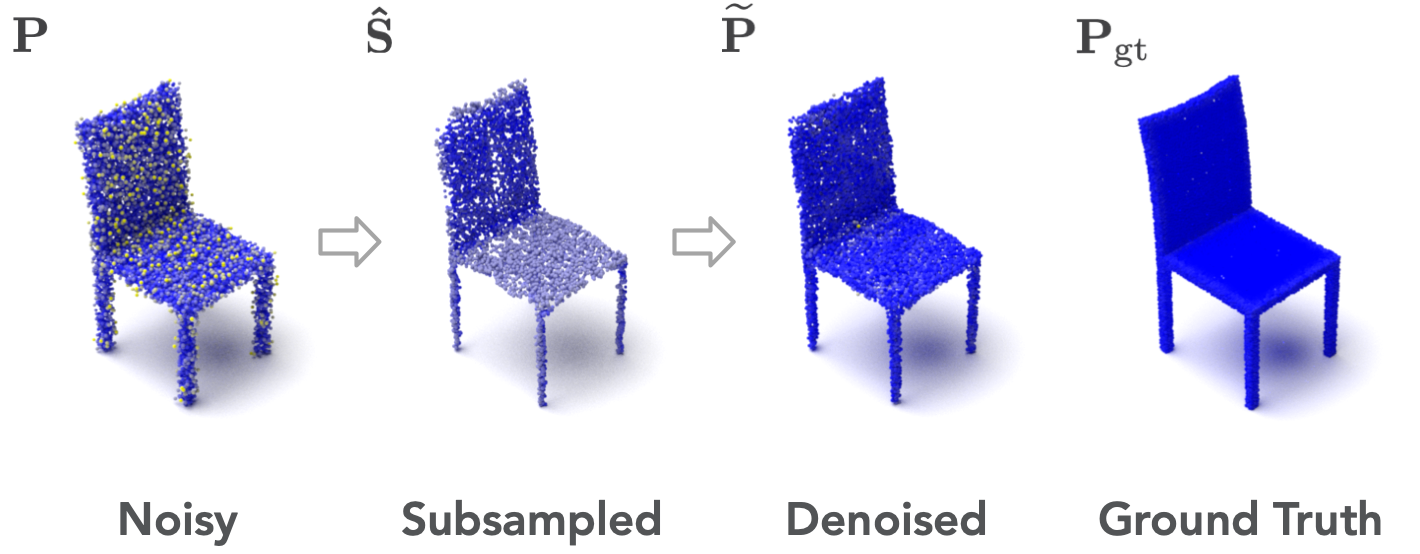Differentiable Manifold Reconstruction
for Point Cloud Denoising
Shitong Luo,
Wei Hu
Wangxuan Institute of Computer Technology
Peking University

Abstract
3D point clouds are often perturbed by noise due to the inherent limitation of acquisition equipments, which obstructs downstream tasks such as surface reconstruction, rendering and so on. Previous works mostly infer the displacement of noisy points from the underlying surface, which however are not designated to recover the surface explicitly and may lead to sub-optimal denoising results. To this end, we propose to learn the underlying manifold of a noisy point cloud from differentiably subsampled points with trivial noise perturbation and their embedded neighborhood feature, aiming to capture intrinsic structures in point clouds. Specifically, we present an autoencoder-like neural network. The encoder learns both local and non-local feature representations of each point, and then samples points with low noise via an adaptive differentiable pooling operation. Afterwards, the decoder infers the underlying manifold by transforming each sampled point along with the embedded feature of its neighborhood to a local surface centered around the point. By resampling on the reconstructed manifold, we obtain a denoised point cloud. Further, we design an unsupervised training loss, so that our network can be trained in either an unsupervised or supervised fashion. Experiments show that our method significantly outperforms state-of-the-art denoising methods under both synthetic noise and real world noise.
Method



Results

| # Points | 20K | 50K | ||||||||||||||
|---|---|---|---|---|---|---|---|---|---|---|---|---|---|---|---|---|
| Noise | 1% | 2% | 2.5% | 3% | 1% | 2% | 2.5% | 3% | ||||||||
| 10-2 | CD | P2S | CD | P2S | CD | P2S | CD | P2S | CD | P2S | CD | P2S | CD | P2S | CD | P2S |
| Bilateral | 1.54 | 1.27 | 1.84 | 1.82 | 2.11 | 2.26 | 2.43 | 2.78 | 1.04 | 0.94 | 1.61 | 1.90 | 1.97 | 2.49 | 2.37 | 3.17 |
| Jet | 1.25 | 0.96 | 2.11 | 2.32 | 2.55 | 3.04 | 2.99 | 3.78 | 1.11 | 1.10 | 2.01 | 2.61 | 2.44 | 3.35 | 2.86 | 4.09 |
| MRPCA | 1.13 | 0.72 | 2.12 | 2.18 | 2.66 | 3.02 | 3.16 | 3.84 | 1.03 | 0.91 | 2.12 | 2.63 | 2.58 | 3.42 | 3.02 | 4.18 |
| GLR | 1.16 | 0.88 | 1.78 | 1.87 | 2.20 | 2.55 | 2.65 | 3.30 | 0.94 | 0.88 | 1.79 | 2.28 | 2.24 | 3.05 | 2.68 | 3.83 |
| TotalDn | 1.51 | 1.23 | 2.57 | 2.97 | 3.02 | 3.75 | 3.46 | 4.51 | 1.13 | 1.03 | 2.20 | 2.80 | 2.66 | 3.60 | 3.09 | 4.37 |
| PCNet | 1.45 | 1.20 | 2.25 | 2.41 | 2.79 | 3.23 | 3.37 | 4.12 | 0.95 | 0.74 | 1.41 | 1.37 | 2.03 | 2.19 | 2.86 | 3.28 |
| Ours (Supervised) | 1.14 | 0.85 | 1.40 | 1.16 | 1.50 | 1.37 | 1.79 | 1.67 | 0.84 | 0.74 | 1.09 | 1.11 | 1.39 | 1.48 | 1.92 | 2.32 |
| Ours (Unsupervised) | 1.45 | 1.35 | 1.82 | 1.92 | 2.07 | 2.22 | 2.32 | 2.71 | 1.14 | 1.23 | 1.65 | 2.14 | 1.89 | 2.59 | 2.22 | 3.21 |
Comparison of denoising methods. Each resolution and noise level is evaluated by 60 point clouds of different shapes from our collected test dataset, which is a subset of ModelNet-40.
Citation
Please consider citing our paper if you find this work helpful:
@inproceedings{luo2020differentiable,
title={Differentiable Manifold Reconstruction for Point Cloud Denoising},
author={Luo, Shitong and Hu, Wei},
booktitle={Proceedings of the 28th ACM International Conference on Multimedia},
year={2020},
month={October}
}